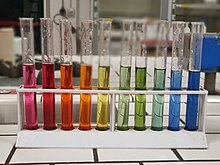
Back PH Afrikaans PH-Wert ALS पीएच मान ANP أس هيدروجيني Arabic PH AST PH Azerbaijani PH BCL Вадародны паказчык Byelorussian Водороден показател Bulgarian पीएच Bihari

In chemistry, pH (/piːˈeɪtʃ/ pee-AYCH), also referred to as acidity or basicity, historically denotes "potential of hydrogen" (or "power of hydrogen").[1] It is a logarithmic scale used to specify the acidity or basicity of aqueous solutions. Acidic solutions (solutions with higher concentrations of hydrogen (H+) ions) are measured to have lower pH values than basic or alkaline solutions.
The pH scale is logarithmic and inversely indicates the activity of hydrogen ions in the solution
where [H+] is the equilibrium molar concentration of H+ (in M = mol/L) in the solution. At 25 °C (77 °F), solutions with a pH less than 7 are acidic, and solutions with a pH greater than 7 are basic. Solutions with a pH of 7 at 25 °C are neutral (i.e. have the same concentration of H+ ions as OH− ions, i.e. the same as pure water). The neutral value of the pH depends on the temperature and is lower than 7 if the temperature increases above 25 °C. The pH range is commonly given as zero to 14, but a pH value can be less than 0 for very concentrated strong acids or greater than 14 for very concentrated strong bases.[2]
The pH scale is traceable to a set of standard solutions whose pH is established by international agreement.[3] Primary pH standard values are determined using a concentration cell with transference by measuring the potential difference between a hydrogen electrode and a standard electrode such as the silver chloride electrode. The pH of aqueous solutions can be measured with a glass electrode and a pH meter or a color-changing indicator. Measurements of pH are important in chemistry, agronomy, medicine, water treatment, and many other applications.
- ^ Jensen, William B. (2004). "The Symbol for pH" (PDF). Journal of Chemical Education. 81 (1): 21. Bibcode:2004JChEd..81...21J. doi:10.1021/ed081p21. Archived (PDF) from the original on 14 December 2019. Retrieved 15 July 2020.
- ^ Lim, Kieran F. (2006). "Negative pH Does Exist". Journal of Chemical Education. 83 (10): 1465. Bibcode:2006JChEd..83.1465L. doi:10.1021/ed083p1465.
- ^ Covington, A. K.; Bates, R. G.; Durst, R. A. (1985). "Definitions of pH scales, standard reference values, measurement of pH, and related terminology" (PDF). Pure Appl. Chem. 57 (3): 531–542. doi:10.1351/pac198557030531. S2CID 14182410. Archived (PDF) from the original on 24 September 2007.

![{\displaystyle {\ce {pH}}=-\log _{10}(a_{{\ce {H+}}})\thickapprox -\log _{10}([{\ce {H+}}])}](https://wikimedia.org/api/rest_v1/media/math/render/svg/a1d35385abf8498456c8f4db35c55b00629d7b7b)